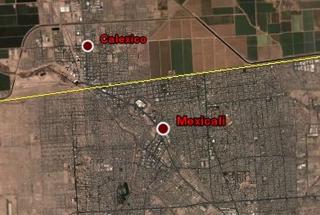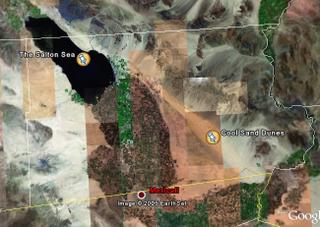
Google earth is the coolest new interweb application on the planet right now. I've been using it to look at all sorts of interesting stuff around the world. I've been paying a lot of attention to the desert southwest for the last couple of days. My impending move to the Sacramento area has spurred me to get a better feel for what's about to become my home state for the next four to six years.
First of all, let's start with this amusing bit of naming information. As you may know, there's a city right on the border between Mexico and California known as "Mexicali." The name of the town on the American side of the border is less well known, and that's a real shame.
Here's a larger picture of the local area. As you can see, Mexicali is to the south. North of that is the Imperial Valley. The lowest point of the Imperial Valley is nearly as far below sea level as Death Valley. There are major agricultural regions to the north and the south. They are separated by a large saline lake known as the Salton Sea.
The Salton Sea is an interesting subject. Not only is it the title of a creepy looking movie, it also didn't exist until 1905. Apparently, heavy rains in conju nction with some poorly built levees on western banks of the Colorado river resulted in the diversion of the entire flow of the river into the Imperial Valley basin. This diverted flow continued for over a year and flooded out over 300 square miles of valley floor. The Salton Sea continues to exist to the present day only because run-off from agricultural operations in the Imperial Valley generally equals the rate of evaporation of water from the lake. Over time, the dissolved salts and other compounds present in the run-off, concentrate in the lake water and result in a constantly increasing level of lake salinity and frequent fish-killing algae bloom. There are no easy long term solutions for this problem. The long term prognosis for the Salton Sea if the agricultural run-off continues and the salt content is not somehow decreased is that it will become more and more like the Dead Sea.
nction with some poorly built levees on western banks of the Colorado river resulted in the diversion of the entire flow of the river into the Imperial Valley basin. This diverted flow continued for over a year and flooded out over 300 square miles of valley floor. The Salton Sea continues to exist to the present day only because run-off from agricultural operations in the Imperial Valley generally equals the rate of evaporation of water from the lake. Over time, the dissolved salts and other compounds present in the run-off, concentrate in the lake water and result in a constantly increasing level of lake salinity and frequent fish-killing algae bloom. There are no easy long term solutions for this problem. The long term prognosis for the Salton Sea if the agricultural run-off continues and the salt content is not somehow decreased is that it will become more and more like the Dead Sea.
Why is this region interesting to me? Well, mainly because it is part of the Sonoran desert. The Sonoran desert is (according to Wikipedia) one of the largest and hottest deserts in North America and home to a lot of really cool and interesting plants and creatures. I would imagine that the Imperial Valley used to be part of the Sonoran desert, but with all the agricultural activity now located there, it probably isn't. Perhaps it will be again someday, if the level of farming present in the desert Southwest becomes impractical for reasons related to water and energy costs.

No comments:
Post a Comment